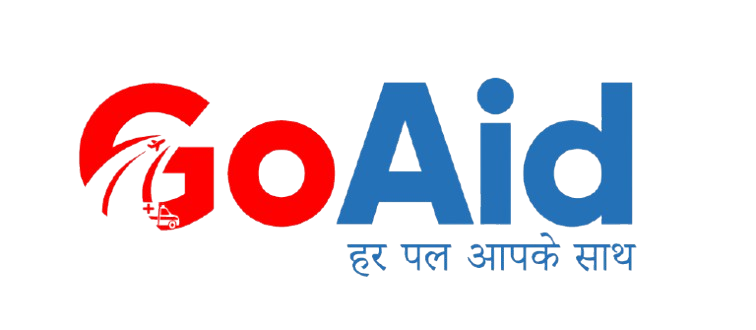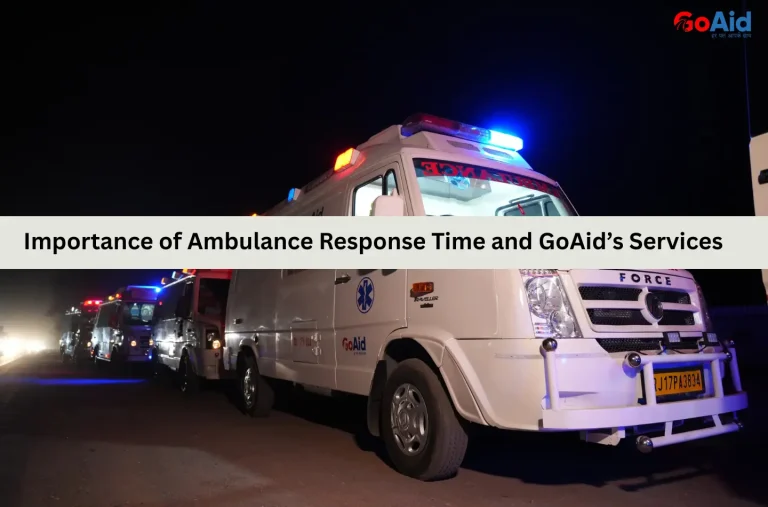In modern emergency healthcare, ambulance fleet management powered by tracking and analytics plays a very important role in improving operational efficiency and patient safety. GoAid Ambulance Service integrates real-time ambulance tracking systems and fleet analytics to monitor routes and ensure rapid responses.
This technology-driven approach enables GoAid to provide IndiaŌĆÖs most reliable and 24/7 smart ambulance service with unmatched accuracy and care.
What Is Ambulance Fleet Management and Why Does It Matter?
Ambulance fleet management refers to the process of overseeing and optimizing ambulance operations through technology, analytics, and monitoring systems. It includes ambulance GPS tracking, route optimization, driver performance assessment, and real-time vehicle maintenance updates. This system ensures better coordination, improved response times, and enhanced safety for both patients and staff.┬Ā
For GoAid Ambulance Service, effective fleet management means efficient dispatching, reduced operational costs, and increased reliability. This allows ambulances to reach patients faster while maintaining the highest standards of care and service quality.
How Tracking Systems Revolutionize Ambulance Management?
Advanced ambulance tracking systems are transforming emergency response by enabling real-time visibility, better coordination, and faster operations. GoAid Ambulance Service uses GPS and smart analytics to improve efficiency, safety, and patient outcomes across its nationwide fleet.
- Real-Time Location Monitoring: GPS tracking allows GoAid to monitor ambulance locations instantly, ensuring the nearest vehicle reaches patients without delay.
- Route Optimization: Smart tracking systems identify the fastest and least congested routes, reducing response times and improving ambulance efficiency during emergencies.
- Enhanced Communication: Real-time updates between dispatchers, drivers, and hospitals ensure smooth coordination and faster medical response.
- Driver Behavior Monitoring: Tracking systems help GoAid evaluate driving speed, route adherence, and safety compliance to reduce risks and maintain service quality.
- Fuel and Resource Management: GPS analytics monitor fuel consumption and vehicle performance, helping reduce operational costs and improve sustainability.
- Improved Patient Safety: Continuous tracking ensures safe and timely transport while allowing immediate intervention in case of route or vehicle issues.
- Transparency and Accountability: Live tracking enables families and hospitals to follow ambulance movement, building trust and transparency in emergency medical services.
The Power of Data Analytics in Ambulance Fleet Performance
Data analytics plays a crucial role in enhancing ambulance fleet performance by turning raw operational data into actionable insights. Through continuous monitoring, GoAid Ambulance Service identifies trends in response times, route efficiency, and maintenance schedules. Analytics-driven decision-making allows optimization of resource allocation, reducing downtime and fuel wastage.
It also ensures predictive maintenance, minimizing vehicle breakdowns during emergencies. By leveraging advanced analytics, GoAid improves overall fleet productivity, enhances patient care delivery, and maintains accountability across all operations. This is transforming how emergency medical services are managed and executed in real time.
How GoAid Ambulance Service Uses Tracking & Analytics for Better Efficiency?
GoAid Ambulance Service uses advanced tracking and analytics to streamline operations, improve coordination, and ensure faster response times, making its ambulance fleet among the most efficient and reliable in India.
- Smart Fleet Monitoring: GoAid tracks every ambulance in real-time to allocate the nearest available vehicle and reduce emergency response times.
- Predictive Maintenance: Analytics help forecast maintenance needs, preventing breakdowns and ensuring vehicles remain in top operational condition.
- Fuel Optimization: GoAid monitors fuel usage and driving patterns to reduce wastage, improve mileage, and enhance overall cost-efficiency.
- Driver Performance Evaluation: Analytics track driver behavior, ensuring adherence to safety norms and improving overall driving standards.
- Demand Forecasting: Predictive analytics anticipate peak demand hours, enabling GoAid to allocate ambulances strategically.
- Faster Dispatch Decisions: Real-time data allows dispatch teams to make quick, informed decisions, reducing delays in emergency response.
- Performance Reporting: Comprehensive analytics reports help GoAid continuously evaluate fleet efficiency and plan operational improvements effectively
How GoAid Ambulance Service Uses Tracking & Analytics for Better Efficiency?
GoAid Ambulance Service utilizes advanced tracking and analytics tools to enhance operational efficiency, minimize delays, and deliver faster, safer, and smarter ambulance dispatches across India, ensuring life-saving care reaches patients without unnecessary waiting time.
- Real-Time Fleet Visibility: GoAid tracks every ambulanceŌĆÖs live location to deploy the nearest available unit, significantly reducing emergency response time.
- Predictive Maintenance Alerts: Analytics monitor vehicle health, predicting potential breakdowns and ensuring every ambulance remains ready for emergency deployment.
- Data-Driven Route Planning: Smart algorithms analyze traffic and route patterns to identify the fastest, safest paths for patient transfers.
- Driver Performance Insights: Analytics evaluate driving behavior, helping GoAid maintain high safety standards and optimize driver training programs.
- Dynamic Resource Allocation: Predictive analytics forecast high-demand zones, ensuring GoAid ambulances are strategically positioned for faster responses
. - Fuel and Cost Optimization: Real-time monitoring minimizes fuel wastage and operational costs, promoting efficient and eco-friendly ambulance operations.
- Performance Evaluation Reports: Analytical reports help GoAid continuously refine its systems, maintaining unmatched speed, safety, and service excellence.
Also Read: Integrating AI and Predictive Analytics in Ambulance Dispatch
Benefits of GoAid Advanced Fleet Management Systems in Ambulance Services
GoAidŌĆÖs advanced fleet management systems provide cutting-edge solutions for better control, safety, and service quality. This helps to make emergency response faster and more efficient while enhancing patient satisfaction and resource utilization.
- Improved Response Time: GPS tracking ensures that the closest ambulance is dispatched immediately, reducing critical arrival delays.
- Enhanced Patient Safety: Real-time monitoring maintains high safety standards and ensures timely medical support during transit.
- Optimized Fleet Utilization: Data-driven insights allow GoAid to use each ambulance effectively, avoiding idle time or overlap.
- Reduced Operational Costs: Efficient route planning and fuel monitoring help minimize unnecessary expenses and maintenance costs.
- Better Coordination: Centralized tracking enhances communication between drivers, hospitals, and control centers for smooth operations.
- Increased Transparency: Analytical data offers full visibility into fleet operations, boosting accountability and service reliability.
- Higher Service Quality: GoAidŌĆÖs tech-driven approach ensures consistent, reliable, and quick ambulance service across multiple cities in India.
Challenges and Future of Fleet Analytics in Emergency Medical Services
Fleet analytics is transforming ambulance operations; however, challenges like data integration, connectivity, and training still exist. However, the future promises smarter, AI-powered solutions for faster, more efficient emergency medical services.
- Data Integration Issues: Combining data from multiple systems remains complex, affecting real-time decision-making efficiency.
- Connectivity Gaps: Limited network coverage in remote areas can disrupt real-time ambulance tracking and communication.
- High Implementation Costs: Deploying advanced analytics tools and GPS systems requires significant investment for smaller operators.
- Data Privacy Concerns: Managing patient and location data securely is essential to maintain confidentiality and compliance.
- Skill Gaps: Staff training on analytics platforms is crucial but often challenging for emergency response teams.
- Technological Maintenance: Regular updates and maintenance are required to keep tracking systems running smoothly.
- Future Outlook: AI and predictive analytics will enable fully automated, efficient, and proactive ambulance fleet management across India.
How GoAid Leads the Way in Smart Fleet Management?
GoAid Ambulance Service sets new standards in smart fleet management through innovation, technology integration, and analytics, ensuring every ambulance operates with maximum speed, efficiency, and reliability across its service network.
- AI-Powered Tracking: GoAid uses AI algorithms to monitor fleet movement, predict demand, and optimize emergency dispatch.
- 10-Minute Response Promise: Advanced systems ensure ambulances reach patients within just 10 minutes of booking.
- Centralized Command Center: A real-time dashboard monitors every ambulance to maintain control and ensure immediate response.
- Predictive Maintenance System: GoAid identifies vehicle issues before they occur, reducing downtime and ensuring continuous service availability.
- Data-Driven Decisions: Analytics-based insights help improve fleet utilization, reduce costs, and enhance patient care efficiency.
- Seamless Communication: Integrated tracking ensures flawless coordination between drivers, hospitals, and dispatch operators.
- Commitment to Innovation: GoAid continuously upgrades its smart ambulance technology to stay ahead in IndiaŌĆÖs emergency medical services landscape.
Conclusion to the Tracking & Analytics in Ambulance Fleet Management
Tracking and analytics have transformed ambulance fleet management by improving response time, reducing operational costs, and ensuring safety. GoAid Ambulance Service leads this revolution with real-time tracking, predictive analytics, and smart fleet systems, delivering faster, safer, and more efficient emergency care across India.
FAQs related to the Tracking & Analytics in Ambulance Fleet Management
Question-1: What is an ambulance GPS tracking system?
Answer: An ambulance GPS tracking system monitors the live location of vehicles, enabling GoAid to dispatch the nearest ambulance and ensure faster response times.
Question-2: How does ambulance fleet management improve efficiency?
Answer: Ambulance fleet management enhances efficiency through route optimization, predictive maintenance, and real-time tracking, reducing delays and operational costs.
Question-3: What are the benefits of real-time ambulance tracking?
Answer: Real-time ambulance tracking allows GoAid to monitor movement, improve dispatch coordination, and ensure patients receive timely medical assistance.
Question-4: How does GoAid use fleet analytics for safety?
Answer: GoAid uses fleet analytics to monitor driving behavior, vehicle condition, and route safety, minimizing risks and ensuring secure patient transfers.
Question-5: What technologies power GoAidŌĆÖs smart ambulance service?
Answer: GoAidŌĆÖs smart ambulance service integrates GPS, AI, predictive analytics, and real-time tracking to deliver fast and reliable emergency medical transport.
Question-6: How does the GoAid fleet tracking system support 24/7 ambulance service?
Answer: The GoAid fleet tracking system operates continuously, ensuring 24/7 ambulance availability, quick response times, and uninterrupted emergency medical support across multiple cities.














